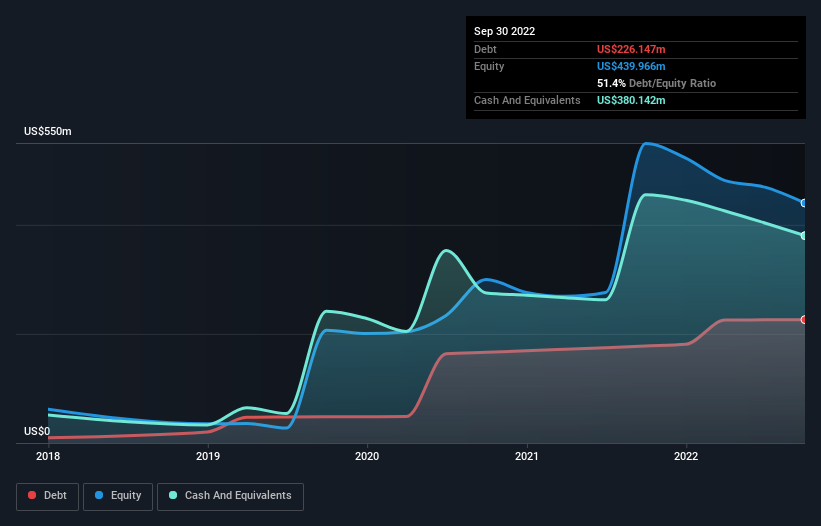
David Iben put it well when he said, 'Volatility is not a risk we care about. What we care about is avoiding the permanent loss of capital.' So it might be obvious that you need to consider debt, when you think about how risky any given stock is, because too much debt can sink a company. We can see that Health Catalyst, Inc. (NASDAQ:HCAT) does use debt in its business. But should shareholders be worried about its use of debt?
When Is Debt Dangerous?
Debt is a tool to help businesses grow, but if a business is incapable of paying off its lenders, then it exists at their mercy. Part and parcel of capitalism is the process of 'creative destruction' where failed businesses are mercilessly liquidated by their bankers. While that is not too common, we often do see indebted companies permanently diluting shareholders because lenders force them to raise capital at a distressed price. Of course, debt can be an important tool in businesses, particularly capital heavy businesses. The first step when considering a company's debt levels is to consider its cash and debt together.
Check out our latest analysis for Health Catalyst
What Is Health Catalyst's Debt?
The image below, which you can click on for greater detail, shows that at September 2022 Health Catalyst had debt of US$226.1m, up from US$177.8m in one year. But on the other hand it also has US$380.1m in cash, leading to a US$154.0m net cash position.

How Healthy Is Health Catalyst's Balance Sheet?
The latest balance sheet data shows that Health Catalyst had liabilities of US$91.1m due within a year, and liabilities of US$245.2m falling due after that. On the other hand, it had cash of US$380.1m and US$49.9m worth of receivables due within a year. So it actually has US$93.9m more liquid assets than total liabilities.
This surplus suggests that Health Catalyst has a conservative balance sheet, and could probably eliminate its debt without much difficulty. Succinctly put, Health Catalyst boasts net cash, so it's fair to say it does not have a heavy debt load! There's no doubt that we learn most about debt from the balance sheet. But ultimately the future profitability of the business will decide if Health Catalyst can strengthen its balance sheet over time. So if you're focused on the future you can check out this free report showing analyst profit forecasts.
In the last year Health Catalyst wasn't profitable at an EBIT level, but managed to grow its revenue by 18%, to US$272m. We usually like to see faster growth from unprofitable companies, but each to their own.
So How Risky Is Health Catalyst?
Statistically speaking companies that lose money are riskier than those that make money. And in the last year Health Catalyst had an earnings before interest and tax (EBIT) loss, truth be told. And over the same period it saw negative free cash outflow of US$47m and booked a US$151m accounting loss. But the saving grace is the US$154.0m on the balance sheet. That means it could keep spending at its current rate for more than two years. Even though its balance sheet seems sufficiently liquid, debt always makes us a little nervous if a company doesn't produce free cash flow regularly. There's no doubt that we learn most about debt from the balance sheet. But ultimately, every company can contain risks that exist outside of the balance sheet. We've identified 2 warning signs with Health Catalyst , and understanding them should be part of your investment process.
At the end of the day, it's often better to focus on companies that are free from net debt. You can access our special list of such companies (all with a track record of profit growth). It's free.
Valuation is complex, but we're here to simplify it.
Discover if Health Catalyst might be undervalued or overvalued with our detailed analysis, featuring fair value estimates, potential risks, dividends, insider trades, and its financial condition.
Access Free AnalysisHave feedback on this article? Concerned about the content? Get in touch with us directly. Alternatively, email editorial-team (at) simplywallst.com.
This article by Simply Wall St is general in nature. We provide commentary based on historical data and analyst forecasts only using an unbiased methodology and our articles are not intended to be financial advice. It does not constitute a recommendation to buy or sell any stock, and does not take account of your objectives, or your financial situation. We aim to bring you long-term focused analysis driven by fundamental data. Note that our analysis may not factor in the latest price-sensitive company announcements or qualitative material. Simply Wall St has no position in any stocks mentioned.
About NasdaqGS:HCAT
Health Catalyst
Provides data and analytics technology and services to healthcare organizations in the United States.
Undervalued with adequate balance sheet.
Similar Companies
Market Insights
Community Narratives



